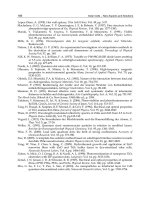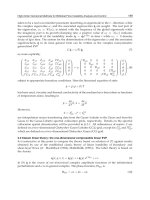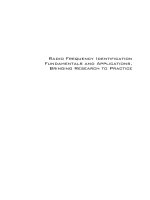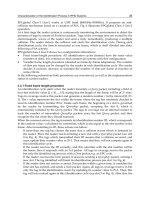Radio Frequency Identification Fundamentals and Applications, Design Methods and Solutions Part 6 pdf
Bạn đang xem bản rút gọn của tài liệu. Xem và tải ngay bản đầy đủ của tài liệu tại đây (427.9 KB, 25 trang )
Near Field On Chip RFID Antenna Design
117
Fig. 7. Z-Smith Chart and the location of the input impedance of the RFID Tag used, Z
RC
.
to get a good Q-factor of the OCA, suitable values for equivalent impedance will be
computed and analyzed. Besides, capacitors influence only in imaginary part of the
impedance within reactance part, but not in resistance. According to all of these OCA
resistance can be designed equally to the Tag resistance, formula 14.
R
OCA
= R
RC
= 80 Ω (14)
On the other hand, relationship between reactance and resistance given below (15) together
with Q-factor around 3, provide a consistent and a reliable design of OCA’s impedance.
33
OCA
OCA OCA
OCA
X
QXR
R
=≈→ ≈ (15)
As a result, a consistent reactance for the tag antenna is X
OCA
≈ 240Ω (L
OCA
=15.6nH) is
concluded. The impedance of OCA could be Z
OCA
=80+j240 Ω, and formula 16 shows the
normalized value according to the characteristic impedance, which is located at the up-
hemisphere of the Smith Chart, figure 8:
0
1,6 4,6
OCA
OCA
Z
Zj
Z
=≈+ (16)
As it can be seen, OCA impedance has an inductive feature, which is coherent with the type
of antenna, a coil. It is actually an inductive set by both the reader and the Tag coils. In this
case, the matching area is the region inside of the Middle-Line and the frontier of the
resistance and conductance in the down-hemisphere.
An ideal case would be if OCA antenna Impedance is exactly as the Chip input one; then
no Matching network would be needed because both stages would be already matched,
figure 9.
Z
RC
Radio Frequency Identification Fundamentals and Applications, Design Methods and Solutions
118
Fig. 8. DP-Nr. 1 (80.0 + j240.0)Ω, Q = 3.0 at 2.450 GHz.
Data Number Point Impedance Ω Q-Factor
1 80-j240 2.9
2 80+j240 2.9
Table 1. Data Point Numbers with its corresponding impedance and Q-factor at 2,45 GHz.
Fig. 9. Z-Smith Chart of the circuit impedance and its corresponding matching conjugated point.
Near Field On Chip RFID Antenna Design
119
Table 1 shows that the Q-factor for the circuit’s impedance - 2,9 - is quite close to the value
we want to reach. Anyway, we have designed a suitable matching network and for that
reason the capacitors inside this network are so small. Actually, using this matching we can
reach Q-factor equal to 3.
Matching Network is used to achieve formula 5 though the use of Smith Chart. According to
the theory of RF adaption, a serial capacitor (C
1
=6.6pF) plus a parallel capacitor (C
2
=2.8pF)
are chosen after analyzing some tests based on Smith Chart and considering desired goals.
Fig. 10. Final Scheme of the Matching Network.
Impedance Ω Q-Factor
Z
RC
80-j232 2.9
Z
OCA
80+j240 3.0
Table 2. impedance and Q-factor at 2,45 GHz
In fact, the set of the Integrated Chip, matching network and transformer can be analyzed as
a RLC resonant circuit. Then, in chapter 4.1, a study of the whole circuit and its response is
going to be performed.
4.1 Resonant circuit RLC parallel process.
The equivalent Circuit model of the Reader plus the entire Tag can be modelled as a parallel
resonant circuit LC (Yan et al, 2006). According to coupling volume theory the resonance is
required to make good use of the power transferred to the label antenna.
1
2
resonant
f
LC
π
=
⋅
(17)
Optimal power transferred to the label antenna is achieved through coil inductance at the
carrier frequency resonance (f
resonant
=f
0
=2.45 GHz). The capacitor’s chip is about 28pF, which
fulfills our goals, also being acceptable compared to other researches (e.g., Sabri et al, 2006).
On the other hand, designed capacitance is charged up to 1.5 V level in less than 50 s
(Gregori et al, 2004) in order to deliver an output voltage higher than 1.2V to the Chip.
After analyzing whole equivalent impedance, set by lumped elements, on the right side of
the Receiver (figure 11), Transformer’s equivalent circuit will lead us to study and
determine the OCA and reader antennas (figure 12).
reader
OCA
L
n
L
= (18)
V
2.8f F
6.6pF
Z
RC
C
1
C
2
Z
OCA
Radio Frequency Identification Fundamentals and Applications, Design Methods and Solutions
120
Fig. 11. The Reader, OCA and Tag equivalent scheme.
Fig. 12. The equivalent circuit of the transformer.
According to the electrical equivalent scheme of the transformer, both coils inductances can
be substituted by the reader antenna introducing a new parameter n, which is the
proportional to the reader antenna and inversely proportional to the Tag.
Assuming that Z is composed by R
OCA
and X
load
in series, as figure 7 shows. Thus, Z=
R
OCA
+R
load
||C
load
= 160 Ω || 270 pF.
Fig. 13. Equivalent RLC circuit
Resonant RLC circuit provides (figure 13), through formula 18 a relationship between both
coils and parameter n, a solution for the reader’s coil at resonant frequency of the circuit, f
0
.
()
2
0
1
2
OCA
reader
L
L
C
f
π
=⋅
⋅
(19)
Actually, the final expression for the Reader’s inductance depends on the value of the
OCA’s inductance and the capacitors located at the matching network. Thus, Tag’s antenna
has been finally designed by L
reader
=15,6 nH and n=1.
1
2
L
reader
C•
n
2
160•
n
2
L
reade
r
L
OCA
Z
IDEAL
L
reade
r
1
2
n : 1
Z’=
n
2
•Z
0
R
OCA
Z
load
L
OCA
L
reader
Near Field On Chip RFID Antenna Design
121
4.2 Lumped element model
Fig. 14. Final equivalent RLC scheme.
As a result, figure 14 shows the equivalent circuit of the entire Tag, which describe the same
behaviour, working at the ressonant frequency and delivering enough voltage to feed the
Chip (wake-up voltage claimed by producer into datasheet is 1.4V). Therefore, the input
signal, after rectifier stage, supplied to the subsequent circuit will be stable for establishing
and mainteinance a communication between reader and Tag within a near field.
5. Tag antenna geometry
The type of chosen antenna is called a magnetic dipole antenna. Where the radius of the
loop and the current (I) which has a Φ orientation and the radiation vector is:
Fig. 15. total Power and Magnetic field radiated by a loop.
ˆ
2
ˆ
''
jkr
NIead
π
φ
φ
<>
=
∫
G
v
(20)
The expressions for the radiation vector in a loop in polar coordinates can be expressed (r, θ, Φ):
2
cos( ')
0
(')'
jka sen
r
N a I sen e sen d
π
θφφ
θ
φφ φ
−
=−
∫
(21)
2
cos( ')
0
cos ( ')
jka sen
NaI e sen d
π
θφφ
θ
θ
φφ φ
−
=−
∫
(22)
2
cos( ')
0
cos( ') '
jka sen
NaIe d
π
θφφ
ϕ
φ
φφ
−
=−
∫
(23)
V1 C270p
Rcc
20
R160
0
VchipVCC
L 15.6n
L
reader
Radio Frequency Identification Fundamentals and Applications, Design Methods and Solutions
122
These last expressions is illustration of the Bessel functions. Computing these formulas
according to the geometry of antenna, we get this new formulas:
0
r
N
=
(24)
0N
θ
=
(25)
2
1
2( )
when a
N j aI J kasen N j k a I sen
λ
φφ
π
φπθ
<<
= ⎯⎯⎯⎯→ = (26)
The correct proof for a circular loop with the uniform current. The total radiated power is:
()
4
2
20
r
PKd ka
π
=Ω=
∫∫
(27)
2
22
2
44
jkr
e
and K N k a I sen
r
φ
η
η
πθ
λπ
−
== (28)
Where η is the impedance wave and k is the wave number.
From the centre of the loop, its near magnetic field radiation falls off with r-3 and increases
linearly with the number of turns N. Reminding that µ0 is the permeability of the free space
(µ
0
=4π·10
-7
).
()
22
22
00
3/2
3
22
2
2
ra
zz
INa INa
BB
r
ar
μμ
>>
=⎯⎯⎯→=
+
(29)
5.1 Structure
OCA schematic structure consists of a copper coil layer (Cu/USG single damascene process
loop) with thickness of 1 µm to come up with both optimal Q-factor for the power
conversion and match the antenna to the subsequent Chip. OCA was also covered by a 0,5
µm silicon nitride as passivation. Then, a thick dielectric undoped SiO
2
(USG) layer ~ 19,3
µm. The coil and Al-shielding layer are interspaced by a SiO
2
dielectric substrate containing
deep vias, with a lower thickness of the metal. In order to resume the mutual EM
interference between OCA and the tag’s circuit an AL-shielding layer is used. It also
enhances the Q-factor, reducing its rate. Finally, the silicon substrate is given by closed
boundary (ground) to represent the backing plate.
5.2 Design
The optimal goal in terms of size, minimizing OCA in order to suit with the Integrated Chip
dimension which is 0,64mm x 0.64 mm. Modelling is initiated by entering the substrate
details of the layers such as shown in figure 16. Details depend upon whether the substrate
layer is ossless, lossy, or a conducting layer, it is important to achieve these parameters in
the l correct manner. For lossless substrates such as silicon dioxide (SiO
2
) the relative
permittivity (ε
r
=4.1) and thickness is entered. For substrates with complex permittivity (and
hence lossy) such as silicon (Si), the real part of the permittivity is entered together with a
conductivity value in S/m. For metals, parameters are conductivity and thickness (Wilson,
2002). The variations of Q-factor pointed to the thickness of the substrate -19,3 µm
Near Field On Chip RFID Antenna Design
123
Fig. 16. The schematic cross-section of tag chip with OCA.
thickness of SiO
2
- of OCA’s Coil (Guo et al, 2004). Nevertheless, Metal thickness (Cu) is set
to 1 µm in order to design the steady antenna, when longer copper increases the real part of
the impedance.
OCA design is performed through software IE3D; all parameters given previously with
adviced geometry of the coil. OCA impedance is characterized through reactance and
resistance computed from the measured S
11
parameter at the working frequency (f
0
= 2.45
GHz), and dimension optimisation is performed in order to reach global goals; both size and
load impedance.
Fig. 17. Initial design.
Going in depth with the main goal, in terms of size, minimizing OCA in order to suit with
the Tag dimension which is 0,64mm x 0.64 mm. Looking at the pattern, by changing the
space of trace width and line spacing, input impedance of the coil becomes modified too.
Actually, when playing with the width on the antenna, it means the breadth of the SiO
2
substrate layer, it is possible to modify the real part of the input impedance of the antenna.
Final goal keeps on the same state; the challenge is to get 80 and 232 Ω as a real and
imaginary part respectively. However, it is possible to play with the width (initially set to 12
µm) of the metals used - copper and aluminium layer - and change also the input
impedance. Do not forget about the length of the inductors metallic layer, in this case
copper. If it is getting longer, then the real part is increasing. Space line is set to 6 µm. It is
1µm
19,3µm
0,5µm
0,13
µ
m
OCA coil made of Co
pp
er
(
Cu
)
Deep vias
AL-shielding layer
Interconnect la
y
er
Circuit Chi
p
(
Si
)
SiO
2
(
USG
)
Radio Frequency Identification Fundamentals and Applications, Design Methods and Solutions
124
important to point it out that the ports are located in the exact place as Pad1 and Pad2, in
order to get the most optimal-real antenna.
Fig. 18. Optimization goal for the real part of S
11
at 2.45 GHz. Objective: Re[S
11
] = 80Ω.
Fig. 19. Optimization goal for the imaginary part of S
11
at 2.45 GHz. Objective: Im[S
11
] =
232Ω.
Indeed, figure 21 shows the final Antenna’s model after optimization process, a rectangular
coil; 0.7 mm x 0.75 mm, which is quite close to the optimal one introduced initially. Looking
at its properties and behaviour, Figure 22 shows the equivalent input impedance, computed
through the S
11
parameter, which fully accomplish the desired properties.
Fig. 20. Layers’ depths
6. Conclusion
The process of fabricating the antenna on the top of the RFID chip eliminates the need for a
separated and costly expensive process for antenna printing and assemblage, compulsory
for a separated “off-chip” antenna which is much more times larger than the chip itself. This
Near Field On Chip RFID Antenna Design
125
Fig. 21. Optimized design.
Fig. 22. Final input impedance of the antenna designed.
technology requires a layer of a suitable dielectric to be deposited on the chip surface and
isolates the antenna from the circuits below. Overall, conventional RFID tags are typically of
a few cm² in size and more expensive as well. In comparison, this newly developed chip
Radio Frequency Identification Fundamentals and Applications, Design Methods and Solutions
126
(EM4222) is considerably miniaturized, less than 1 mm² and at a lower cost, which is packed
with powerful functions too. Furthermore, designed On-Chip Antenna (OCA) is based on
inductive coupling technology resonating at the working frequency selected and embedded
into the Chip. The antenna is performed by the coil and it is modelled by lumped elements
and it is implemeted through 3D EM simulation tool; the software used to perform this
design in IE3D.
Design at glance, both the Reader and the Tag coils are drawn together in order to deliver
the maximum signal permitted to wake up the Chip. The matching network stage must be
designed in order to deliver maximum power from the Tag coil to the Chip. However, the
final Antenna designed (0.7 mm x 0.75 mm) is a bigger than the Chip (0,64mm x 0.64 mm),
but considered optimal since it is refered to a milimeter scale and its features accomplish
main goals in the terms of adaptation. Our results, according to settings and chosen
materials, bring into agreement with the tittle of this chapter, a small OCA antenna
operating within the near field.
7. Acknowledgement
This work has been conducted in the Department of Telecommunication Engineering at the
Czech Technical University in Prague and supported by the Ministry of Education, Youth,
and Sport of the Czech Republic under research program MSM6840770038.
8. References
Atmel Corporation. (2002). Atmel release document. Tag Tuning/RFID, application Note.
2055A–RFID–07/02. San Jose. USA.
Lauss Finkenzeller. (2003). RFID Handbook, fundamentals and Applications in Contactless Smart
Cards and Identification. Editorial Wiley, pp 20.
Stefano Gregori, Yunlei Li, Huijuan Li, Jin Liu, Franco Maloberti,. (2004). ISLPED’04, August
9–11 2.45 GHz Power and Data Transmission for a Low-Power Autonomous
Sensors Platform. California. USA.
L. H. Guo, W. G. Yeoh, Y. B. Choi, X. S. Chen, H. Y. Li, M. Tang, G. Q. Lo, N.
Balasubramanian, and D. L. Kwong. (2004). Design and Manufacturing of Small Area
On-Chip-Antenna (OCA) for RFID Tags. Institute of Microelectronics, 11 Science Park
Road, Singapore.
L. H. Guo, A. P. Popov, H. Y. Li, Y. H. Wang, V. Bliznetsov, G. Q. Lo, N. Balasubramanian,
and D L. Kwong. (2006). A Small OCA on a 1×0.5-mm2 2.45-GHz RFID Tag—Design
and Integration Based on a CMOS-Compatible Manufacturing Technology. IEEE electron
device letters, vol. 27, no. 2, february 2006.
Lluis Prat Viñas. (1999). Circuits and electronics devices. Electronic’s theory. UPC Publishing. pp
169. Barcelona. Spain.
Sabri Serkan Basat, Dr. Manos M. Tentzeris, Dr. John Papapolymerou, Dr. Joy Laskar. (2006).
Design and characterization of RFID modules inmultilayer configurations. Georgia
Institute of Technology, December. Georgia.
M. Usami. (2004). An ultra small RFID chip: µ-chip. Proc. RFIC, 2004, pp. 241–244 Japan.
H. Yan, J.G. Marcias Montero, A. Akhnoukh, L.C.N. de Vreede, J.N. Burghartz. (2006). An
Integration for RF Power Harvesting. DIMES institute of the Delf. University of
Technology. Netherlands.
M P Wilson. (2002). Modelling of integrated VCO resonators using Momentum. Tality,UK.
8
RFID TAGs Coil's Dimensional
Parameters Optimization
As Excitable Linear Bifurcation System
Ofer Aluf
Department of Physics, Ben-Gurion University of the Negev, Be'er-Sheva,
Israel
1. Introduction
In this article, Very Crucial subject discussed in RFID TAG's Coil design. RFID Equivalent
circuits of a Label can be represent as Parallel circuit of Capacitance (Cpl), Resistance (Rpl),
and Inductance (Lpc). The Label measurement principal is as follow: Label positioned in
defined distance to measurement coil, Low current or voltage source, Measuring of |Z| and
Teta of measurement coil, Resonance frequency fro at Teta = 0, Calculation of unloaded
quality factor Q0 out of measured bandwidth B0. The Coil design procedure is based on
three important steps. The first is Preparations: Definition of limits and estimations,
Calculation of parameters. The second is Matrix Run 1: Definition of matrix, Equations and
Calculations, Sample production, evaluation of samples, and Re calculation of parameters.
The third is Matrix Run 2: Definition coil parameters, samples production, evaluation of
samples, and decision on best parameters. Any RFID Coil design include definition of
Limits and estimations, Maximum dimensions of coil (Maximum overall length, width),
definition of the minimum gap between tracks and track thickness. It is very important to
emphasis that basic Label IC (NXP I CODE for example), equivalent circuit is Capacitor
(Cic) and Resistor (Ric) in parallel. The additional coil traces give the complete RFID
equivalent circuit (Capacitor, Resistor, and inductor in parallel). The RFID equivalent circuit
can be represent as a differential equation which depending on variable parameter. The
investigation of RFID's differential equation based on bifurcation theory, the study of
possible changes in the structure of the orbits of a differential equation depending on
variable parameters. The article first illustrate certain observations and analyze local
bifurcations of an appropriate arbitrary scalar differential equation. Since the implicit
function theorem is the main ingredient used in these generalizations, include a precise
statement of this theorem. Additional analyze the bifurcations of a RFID's differential
equation on the circle. Bifurcation behavior of specific differential equations can be
encapsulated in certain pictures called bifurcation diagrams. All of that for optimization of
RFID TAG's dimensional parameters optimization – to get the best performance.
2. RFID TAG equivalent circuit
RFID TAG can be represent as a parallel Equivalent Circuit of Capacitor and Resistor in
parallel. For example see below NXP/PHILIPS ICODE IC Parallel equivalent circuit.
Radio Frequency Identification Fundamentals and Applications, Design Methods and Solutions
128
Fig. 1.
Fig. 2.
The RFID TAG Antenna can be represents as Parallel inductor to the basic RFID Equivalent
Circuit. The simplified complete equivalent circuit of the label is as below:
Fig. 3.
C1 = Cic + Ccon + Cc, R1 = (Ric * Rpc)/(Ric + Rpc) .
1*,1*
dIl dVc
Vl L Ic C
dt dt
==
I-CODE RFID TAG
LA
LB
Antenna
RFID TAGs Coil's Dimensional Parameters Optimization As Excitable Linear Bifurcation System
129
1
0
1
1*1*
1
t
Il Vl dt
L
=
∫
1
3
1
0
1
0, 1* * * 0
11
tt
i
i
t
VdV
Ii C V dt
RdtL
=
=
=
=
=
++ =
∑
∫
2
2
11
*1* *0
11
V
dV
CV
Rdt L
d
d
t
+
+=
we get differential equation of RFID TAG sys which describe the evolution of the sys in
continues time. V = V(t).
Now I define the following Variable setting definitions:
1
2,1
dV dV
VVV
dt dt
=
==
And get the dynamic equation system:
1
2
dV
V
dt
=
21 1
*2 *1
1* 1 1* 1
dV
VV
dt C R C L
=− −
The system shape is as Non linear system equations:
1
1( 1, 2 , )
dV
f
VV Vn
dt
=
,
2
2( 1, 2 , )
dV
f
VV Vn
dt
=
The V1 and V2 variables are the phase space dimension two.
Now Lets Move to three variables system – which the time (t) is the third variable, V3 = t.
1
2
dV
V
dt
=
,
21 1
*1 *2
1* 1 1* 1
dV
VV
dt C L C R
=
−− +
,
3
1
dV
dt
=
Now we get the RFID's coil dimensional parameters:
2*( )/ , 0 *( ), 0 *( )dtwAavgaNcgwBavgbNcgw=+Π =− + =− +
a0, b0 – Overal dimensions of the coil.
Aavg, Bavg – Average dimensions of the coil.
t – Track thickness, w – Track width, g – Gap between tracks.
Nc – Number of turns, d – Equivalent diameter of the track.
Average coil area; -Ac=Aavg * Bavg. Integrating all those parameters give the equations for
inductance calculation:
22
2* *
1*ln
*( )
Aavg Bavg
XAavg
dAavg
Aavg Bavg
⎛⎞
⎜⎟
=
⎜⎟
⎜⎟
++
⎝⎠
Radio Frequency Identification Fundamentals and Applications, Design Methods and Solutions
130
Fig. 4.
22
2* *
2*ln
*( )
Aavg Bavg
XBavg
dBavg
Aav
g
Bav
g
⎛⎞
⎜⎟
=
⎜⎟
⎜⎟
++
⎝⎠
22
32*XAavgBavg
A
avg Bavg
⎡
⎤
⎡
⎤
=+− +
⎢
⎥
⎢
⎥
⎣
⎦
⎣
⎦
4( )/4XAavgBavg=+ , The RFID's coil calculation inductance expression is
[]
0
*1234*
p
Lcalc X X X X
Nc
μ
π
⎡
⎤
=+−+
⎢
⎥
⎣
⎦
, L1 = Lcalc
Definition of limits, Estimations: Track thickness t, Al and Cu coils (t > 30um). The printed
coils as high as possible. Estimation of turn exponent p is needed for inductance calculation.
Coil manufacturing technology P
Wired 1.8 – 1.9
Etched 1.75 – 1.85
Printed 1.7 – 1.8
Table 1.
Now I integrate the Lcalc value inside the differential equations which characterize the RFID
system with the Coil inductance.
1
0* 1 1* 2 0* 3
dV
VVV
dt
=++
[]
21 1
*1 *20*3
0
1* 1
1* *1234*
p
dV
VVV
dt C R
CXXXX
Nc
μ
π
=− − +
⎡⎤
+−+
⎢⎥
⎣⎦
w
A0
B0
Aavg
Bavg
g
RFID TAGs Coil's Dimensional Parameters Optimization As Excitable Linear Bifurcation System
131
3
0* 1 0* 2 0* 3 1
dV
VVV
dt
=
+++
The above differential equations can be represent as Matrix formulation:
[]
010
10
11
{}{}0*20
0
1* 1
1* *1234*
31
3
000
p
V
V
CR
CXXXX
V
dV
dt
Nc
μ
π
⎡⎤
⎡⎤
⎢⎥
⎢⎥
⎢⎥
⎡
⎤⎡⎤
⎢⎥
⎢⎥
⎢
⎥⎢⎥
⎢⎥
=− − +
⎢⎥
⎢
⎥⎢⎥
⎢⎥
⎡⎤
⎢⎥
+−+
⎢
⎥⎢⎥
⎢⎥
⎢⎥
⎣
⎦⎣⎦
⎢⎥
⎣⎦
⎢⎥
⎢⎥
⎢⎥
⎣⎦
⎣⎦
dV1
dt
dV2
dt
3. RFID TAG as a dynamic system
The above representation can be represent as dynamical system. Lets first represent it as f(x),
x formulation.
11
22
33
dX dV
dt dt
dX dV
dt dt
dX dV
dt dt
⎡
⎤⎡ ⎤
⎢
⎥⎢ ⎥
⎢
⎥⎢ ⎥
⎢
⎥⎢ ⎥
=
⎢
⎥⎢ ⎥
⎢
⎥⎢ ⎥
⎢
⎥⎢ ⎥
⎢
⎥⎢ ⎥
⎣
⎦⎣ ⎦
,
11
22
33
XV
XV
XV
⎡
⎤⎡ ⎤
⎢
⎥⎢ ⎥
=
⎢
⎥⎢ ⎥
⎢
⎥⎢ ⎥
⎣
⎦⎣ ⎦
Get the following three dimensional linear system: The X1 X4 inside matrix elements are
not related to Variable X1 in the vector column ! later we return to the original
representation by by substitute Xi by Vi.
[]
010
10
11
{}{}0*20
0
1* 1
1* * 1 2 3 4 *
31
3
000
p
X
X
X
X
CR
CXXXX
X
dX
dt
Nc
μ
π
⎡⎤
⎡⎤
⎢⎥
⎢⎥
⎢⎥
⎡
⎤⎡⎤
⎢⎥
⎢⎥
⎢
⎥⎢⎥
⎢⎥
=− − +
⎢⎥
⎢
⎥⎢⎥
⎢⎥
⎡⎤
⎢⎥
+−+
⎢
⎥⎢⎥
⎢⎥
⎢⎥
⎣
⎦⎣⎦
⎢⎥
⎣⎦
⎢⎥
⎢⎥
⎢⎥
⎣⎦
⎣⎦
d1
dt
d2
dt
The notation of a dynamical system is the mathematical formalization of general scientific
concept of a deterministic process, in our case RFID equivalent circuit evolution with time.
The future and past states of RFID systems can be predicted to a certain extent by knowing
their present state and the laws governing their evolution. Provided these laws do not
change in time, the behavior of such a system could be considered as completely defined by
its initial state. Thus, the notion of a dynamical system includes a set of its possible states
(state space) and a law of the evolution of the state in time. All possible states of the RFID
system can be characterized by the points of some set X. This set is called the state space of
the system. Actually, the specification of a point x belong to X must be sufficient not only to
describe the current "position" of the system but also to determine its evolution. Often, the
state space is called a phase space, following d tradition from classical mechanics. The
following linear system is the right representation:
Radio Frequency Identification Fundamentals and Applications, Design Methods and Solutions
132
1
1( 1, 2, 3)
2
2( 1, 2, 3)
3
3( 1, 2, 3)
dX
fxxx
dt
dX
fxxx
dt
dX
f
xxx k
dt
=
=
=
+
The above three equations can be investigate as two pair of simultaneous differential
equations of the form:
1
1( 1, 2)
2
2( 1, 2)
dX
f
xx
dt
dX
f
xx
dt
=
=
1( 1, 2, 3) 1( 1, 2), 2( 1, 2, 3) 2( 1, 2)
f
xxx fxx f xxx f xx
=
=
1
2
:;(),1,2
var .
: ;,,,( 1, 2) ( 1, 2) 1,2
I Open Interval
xi I t xi t i
be function of a real iable t
fi x x fi x x i
−
∈
→→ ∀=
→→∀=
\
\
\
^
\
It will be convenient to use Boldface letters to denote vector quantities. For instance, if we let:
2
2
12
( 1, 2), ( , ), , , , ( 1, 2)
()
.: ;
dX dx dx
Xxx andf ff
dt dt dt
dX
then f X
dt
Norm on function
XX
== =
→=
→→
\
\
\
Consequently, all of the qualitative results concerning differential equations will be
independent of the choice of norm. Quantitative results, on the other hand, will of course
depend on the norm. Since the function f is independent of t, on any line parallel to the t axis
the segments of the direction field all have the same slope. Therefore, it is natural to
consider the projections of the direction field and the trajectories of equation dX/dt=f(x)
onto the (x1,x2) plane. To each point x on the (x1,x2) plane, when f(x) is defined, Association
the vector f(x)=(f1(x),f2(x)) which should be thought of as being based on x. Assign to the
point x the directed line segment from x to x + f(x). Now lets go back to 2 x 2 matrix
representation of the system respect to two variables V1 and V2.
[]
01
1
11
{}{}
2
0
1* 1
1* *1234*
p
V
V
CR
CXXXX
Nc
μ
π
⎡⎤
⎡⎤
⎢⎥
⎢⎥
⎡
⎤
⎢⎥
=∗
⎢⎥
−−
⎢
⎥
⎢⎥
⎡⎤
⎢⎥
⎣
⎦
+−+
⎢⎥
⎢⎥
⎢⎥
⎣⎦
⎣⎦
⎣⎦
dV1
dt
dV2
dt
RFID TAGs Coil's Dimensional Parameters Optimization As Excitable Linear Bifurcation System
133
and denote the matrix's elements as functions K1 and K2 of Coil overall parameters.
[]
1
11(0,0,,,, ,,,1,1){ }
0
1* * 1 2 3 4 *
1
22(0,0,,,,,,,1,1){ }
1* 1
C
p
C
KKabwgd tpCR
CXXXX
KKabwgd tpCR
CR
N
Nc
N
μ
π
==−
⎡
⎤
+−+
⎢
⎥
⎣
⎦
==−
Denote the RFID Matrix systems with those K1, K2 parameter function gives:
01 1
12 2
V
KK V
⎡⎤
⎢⎥
⎡
⎤⎡ ⎤
=∗
⎢⎥
⎢
⎥⎢ ⎥
⎢⎥
⎣
⎦⎣ ⎦
⎢⎥
⎣⎦
dV1
dt
dV2
dt
Now consideration of trajectories of the form:
()
t
Vt S
e
λ
∗
=
∗
Where S <> 0 is some fixed vector to be determined, and
λ
is a growth rate, also to be
determined. If such solution exist, they correspond to exponential motion along the line
spanned by the vector S. To find the condition on S and
λ
, we substitute
()
t
Vt S
e
λ
∗
=
∗
into
.
01
12
VAV
A
KK
=∗
⎡
⎤
=
⎢
⎥
⎣
⎦
and obtain
tt
SAS
ee
λλ
λ
∗∗
∗∗=∗∗ and cancellation the nonzero scalar factor
t
e
λ
∗
yields to SAS
λ
∗= ∗ which state that the desired straight line solutions exist if S is an
eigenvector of A with corresponding eigenvalue
λ
and the solution is eigensolution. The
eigenvalues of a matrix A are given by the characteristic equation
det( ) 0AI
λ
−
∗= when I
is the identity matrix
10
01
I
⎡
⎤
=
⎢
⎥
⎣
⎦
, we get
2
2
2
1,2
det( ) 0 1 1
() 0 2 2
0
210
11
241
22
2
AKK
trace A K K
KK
KK
K
τ
τλ
λ
λ
λ
λ
Δ= = − =−
==+=
−∗+Δ=
−∗−=
=∗ ±∗ +∗
The above
1,2
λ
is a quadratic solution.
The typical solution is for the eigenvalues to be distinct 1 2
λ
λ
≠
. In this case, a theorem of
linear algebra states that the corresponding eigenvectors S1 and S2 are linear independent, and
hence span the entire plane. Any initial condition V0 can be written as a linear combination of
eigenvectors, V0=C1*S1+C2*S2. Then the general solution for V(t) it is simply
Radio Frequency Identification Fundamentals and Applications, Design Methods and Solutions
134
12
() 1 1 2 2
tt
Vt C S C S
ee
λλ
∗∗
=
∗∗+∗∗.
By insertion quadratic solutions into the last V(t) equation we get
22
11 11
241 241
22 22
22
() 1 1 2 2
KKt KKt
KK
Vt C S C S
ee
⎡⎤⎡⎤
∗+∗ +∗ ∗ ∗−∗ +∗ ∗
⎢⎥⎢⎥
⎣⎦⎣⎦
=∗ ∗+∗ ∗
Now I use the theorem that state, if a coefficient matrix A has at least one eigenvalue with
zero real part, then the planar linear system
.
A
V
V
=
∗
is topologically equivalent to
precisely one of the following five linear systems with the indicated coefficient matrices, in
our case only two options from five can fit;
01
;
00
01
;
10
two zero ei
g
envalues but one ei
g
envector
two purely imaginary eigenvalues
⎡⎤
→
⎢⎥
⎣⎦
⎡⎤
→
⎢⎥
−
⎣⎦
Lets implement each case option to our RFID sys
01
10
⎡
⎤
⎢
⎥
−
⎣
⎦
Fig. 5.
To fulfill the above behavior K2 = 0 and K1 = -1, In our case
[]
[]
1
20,{ }0,1,1
1* 1
1
11,{ }1
0
1* * 1 2 3 4 *
1234
10
p
p
KCR
CR
K
CXXXX
XXXX
C
Nc
Nc
μ
π
π
μ
→∀− →∀ →∞
=
−∀− =−
⎡⎤
+−+
⎢⎥
⎣⎦
+−+ =
∗∗
V2
V1
RFID TAGs Coil's Dimensional Parameters Optimization As Excitable Linear Bifurcation System
135
From above K1 condition we get RFID overall relationship.
[]
1234
10
p
XXXX
C
Nc
π
μ
+−+ =
∗∗
then
22 22
22
2* * 2* *
*ln *ln
*( ) *( )
2* ( )/4
10
p
Aavg Bavg Aavg Bavg
Aavg Bavg
dAavg dBavg
Aavg Bavg Aavg Bavg
C
Aavg Bavg Aavg Bavg
Aavg Bavg
Nc
π
μ
⎡ ⎤
⎛⎞⎛⎞
⎢ ⎥
⎜⎟⎜⎟
+
⎢ ⎥
⎜⎟⎜⎟
⎢ ⎥
⎜⎟⎜⎟
++ ++
⎝⎠⎝⎠
⎢ ⎥
⎢ ⎥
⎡⎤
⎡⎤
⎢ ⎥
−+− + ++=
⎢⎥
⎢⎥
⎣⎦
⎢ ⎥
∗∗
⎣⎦
⎣ ⎦
In case the A matrix is
01
00
⎡
⎤
⎢
⎥
⎣
⎦
Fig. 6.
to fulfill those A matrix conditions , the following K1, K2 condition must exist:
[]
[]
1
20,{ }0,1,1
1* 1
1
10,{ }0
0
1* *1234*
0
1* * 1 2 3 4 *
p
p
KCR
CR
K
CXXXX
CXXXX
Nc
Nc
μ
π
μ
π
→∀− →∀ →∞
=
∀− =
⎡⎤
+−+
⎢⎥
⎣⎦
⎡⎤
+−+ →∞
⎢⎥
⎣⎦
4. RFID TAG behavior based on eigensolutions and eigenvalues
characterization
Sketch a typical phase portrait for the case
V1
V2
Radio Frequency Identification Fundamentals and Applications, Design Methods and Solutions
136
[]
[]
22
2
2
2
2
210
11 11
2412410
22 22
1 0 2 4 1
11
{} 4{ }
0
1* 1
1* *1234*
14
{}
0
1* 1
1* *1234*
21
11
241
22
22
2
1
{}
1* 1
1
{}
1* 1
2
p
p
KKKK
KK
CR
CXXXX
CR
CXXXX
KK
KK
K
CR
Nc
CR
Nc
K
λλ
λ
μ
π
μ
π
λλ
<<
∗−∗+∗<∗+∗+∗<
<→−> +∗
−− > + ∗−
⎡
⎤
+−+
⎢
⎥
⎣
⎦
>−
⎡⎤
+−+
⎢⎥
⎣⎦
<
∗−∗ +∗<
−
2
22 2
11
241
22
0 4 1 4 1 0 4 1
2
22 2
KK
KK K
K
KK K
∗+∗ +∗
<+∗→ +∗>→ >−∗
[]
[]
2
2
1
4{ }
0
1* *1234*
4
0
1* *1234*
1
{}
1* 1
1
{}
1* 1
p
p
CXXXX
CXXXX
CR
Nc
CR
Nc
μ
π
μ
π
>− ∗ −
⎡
⎤
+−+
⎢
⎥
⎣
⎦
>
⎡⎤
+−+
⎢⎥
⎣⎦
−
Then both eigensolutions decay exponentially. The fixed point is a stable node, except
eigenvectors are not mutually perpendicular, in general. Trajectories typically approach the
origin tangent to the slow eigendirection, defined as the direction spanned by the
eigenvector with the smaller
λ
. In backword time t →∞ the trajectories become parallel
to the fast eigendirection.
if we reverse all the arrows in the above figure, we obtain a typical phase portrait for an
unstable node. Now I investigate the case when eigenvalues are complex number. If the
eigenvalues are complex, the fixed point is either a center or a spiral. The origin is
surrounded by a family of closed orbits. Note that centers are neutrally stable, since nearby
trajectories are neither attracted to nor repelled from the fixed point. A spiral would accur if
the RFID sys were lightly damped. Then the trajectory would just fail to close, because the
RFID sys loses a bit of energy on each cycle. To justify these statements, recall that the
eigenvalues are
2
1,2
2
11
241
22
410
2
2
KK
K
K
K
λ
=∗ ±∗ +∗
+∗ <
RFID TAGs Coil's Dimensional Parameters Optimization As Excitable Linear Bifurcation System
137
Fig. 7.
To simplify the notation, lets write the eigenvalues as
[] []
[]
22
2
1,2
11 11
241 241
22 22
11
,2, 41
22
22
0 ( ) 1 1 2 2
' , ' , sin , '
() 1 1 2 2
2
'
KKt KKt
it it
it
iK K
KK
Vt C S C S
C s S s complex ce s complex
Vt C S C S
K
ee
ee
Euler s fo
αω αω
ω
αωα ω
ω
λ
λ
⎡⎤⎡⎤
∗+∗ +∗ ∗ ∗−∗ +∗ ∗
⎢⎥⎢⎥
⎣⎦⎣⎦
+∗ −∗
∗
=± =∗ =−∗ +∗
≠∃ = ∗ ∗ + ∗ ∗
=∗ ∗+∗ ∗
[] []
cos sin
ti t
rmula e
ωω
=∗+∗∗
→
Hence V(t) is a combination of terms involving
[] []
cos , sin
tt
tt
ee
αα
ωω
∗∗
∗
∗∗∗
Such terms represent exponentially decaying oscillations if
Re( ) 0
α
λ
=
<
And growing if 0
α
> . The corresponding fixed points are stable and unstable spirals,
respectively. If the eigenvalues are pure imaginary 0
α
=
, then all the solutions are
periodic with period
2
T
π
ω
∗
= . The oscillators have fixed amplitude and the fixed point is
center. For both centers and spirals, its easy to determine whether the rotation is clockwise
or counterclockwise.
11
2{ }
221*1
11
0 { } 0 0
21*1 21*1
11
0 { } 0 0
21*1 21*1
K
CR
Decaying oscillators
CR CR
Growing oscillators
CR CR
α
α
α
=∗ =−
∗
∀
<→− <→ >
∗∗
∀
>→− >→ <
∗∗
C1, R1 > 0 always then only the first behavior, decaying oscillator can exist in our RFID system.
V1
V2
Radio Frequency Identification Fundamentals and Applications, Design Methods and Solutions
138
Re( ) 0
α
λ
=
< 0
α
>
Fig. 8.
In all analysis until now, we have been assuming that the eigenvalues are distinct. What
happens if the eigenvalues are equal ? Suppose eigenvalues are equal 1 2
λ
λλ
=
= then
there are two possibilities: either there are two independent eigenvectors corresponding to
λ
, or there's only one. If there are two independent eigenvectors, then they span the plane
and so every vector is an eigenvector with this same eigenvalue
λ
. To see this, lets write an
arbitary vector X0 as a linear combination of the two eigenvectors: X0=C1*S1+C2*S2.
Then
0(1122)1 12 2 0
A
XACSCS C SC S X
λλλ
∗=∗∗+∗ =∗∗+∗∗=∗
X0 is also an eigenvector with eigenvalue
λ
. Since the multiplication by A simply stretches
every vector by a factor
λ
, the matrix must be a multiple of the identity :
0
0
A
λ
λ
⎡⎤
=
⎢⎥
⎣⎦
then if 0
λ
≠
, all trajectories are straight lines through the origin
() 0
t
Xt X
e
λ
∗
=∗ and the fixed point is a star node. On the other hand, if
λ
=0 the whole
plane is filled with fixed points.
Lets now sketch the above options with RFID Overal parameters restriction.
12 0
λ
λλ
==≠ then
[]
22
222
2
11 11
241241
22 22
410 410 41
0
*1234* 14
22
222
1
p
KKKK
KK K
XXXX C
KK
KKK
Nc
R
μ
π
∗+∗ +∗=∗−∗ +∗
+∗ =→ +∗ =→ =−∗
+−+ =∗∗
Now lets summarize the classification of fixed points in RFID system based on all
investigation I did. It is easy to show the type and stability of all the different fixed points on
a single diagram.
2
2
4410,221
2
KK K
K
τ
−∗Δ= +∗ = → =∗−
()()
22
1,2
2
() 2, det() 1
1
210, 4
2
12 2, 12 1
1 2 0
trace A K A K
KK
KK
Charecteristic equation
τ
λτ
τλ λ λ λ
λλ λλ τλ
λλτ
λ
=
=Δ= =−
⎡⎤
−∗−= =∗± −∗Δ
⎢⎥
⎣⎦
=+= Δ=∗=−
−
∗− = −∗+Δ=
RFID TAGs Coil's Dimensional Parameters Optimization As Excitable Linear Bifurcation System
139
Fig. 9.
Fig. 10.
0 ( 1 0)KΔ< >
0 ( 1 0)K
Δ
><
0 ( 1 0)K
Δ
==
The eigenvalues are real
and have opposite sign
hence the fixed point is a
saddle point,
The eigenvalues are either
real with the same sign
(nodes), or complex
conjugate (spiral & centers).
At least one of the
eigenvalues is zero. Then
the origin is not an isolated
fixed point. There is either a
whole line of a fixed points,
or a plane of fixed point
Table 2.
Δ
Saddle
points
Unstable
nodes
Unstable
spirals
stable
spirals
stable
nodes
Centers
τ
V1
V2
Radio Frequency Identification Fundamentals and Applications, Design Methods and Solutions
140
Nodes satisfy
2
40
τ
−
∗Δ> and spirals satisfy
2
40
τ
−
∗Δ< . The parabola
2
40
τ
−∗Δ= is
the borderline between nodes and spirals. Star nodes and degenerate nodes live on this
parabola. The stability of the nodes and spirals is determined by
τ
value. When 0
τ
< , both
eigenvalues have negative real parts, so the fixed point is stable. Unstable spirals and nodes
have
0
τ
> . Neutrally stable centers live on the borderline 0
τ
=
, where eigenvalues are
purely imaginary.
5. RFID system phase plan
For our RFID system the general form of a vector field on the phase plan is
.
.
11(1,2)
22(1,2)
VfVV
VfVV
=
=
Where V1 is the voltage on RFID system (V) and V2 is the derivative of that voltage respect
with time (dV/dt). The f1 and f2 are given functions and this system can be written more
compactly in vector notation as:
()
dV
f
V
dt
=
Where V=(V1,V2) and f(V)=(f1(V), f2(V)). Here V represents a point in the phase plane
(RFID voltage at time t), and dV/dt is the voltage change in time at that point. By flowing
the vector field, a phase point traces out a solution V(t), corresponding to a trajectory
winding through the phase plan.
Fig. 11.
Furthermore, the entire phase plane is filled with trajectories, since each point can play the
role of an initial condition. The most salient features of phase portrait are:
1.
Fixed points satisfy f(V*)=0, and correspond to steady states or equilibria of the system.
2.
The closed orbits, these correspond to periodic solutions, i.e. solutions for which
V(t+T) = V(t) for all t values, and T>0.
3.
The stability or instability of the fixed points and closed orbits. Some fixed points are
unstable, because nearby trajectories tend to move away from them, where the closed
orbit is stable.
Now lets sketch the numerical computation of RFID phase portraits. Using Runge - Kutta
method, which in vector form is the following:
V(t)
dV(t)/dt









